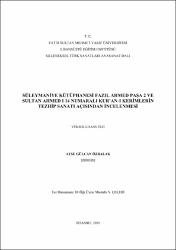Süleymaniye Kütüphanesi Fazıl Ahmed Paşa 2 ve Sultan Ahmed I 14 Numaralı Kur’an-ı Kerimlerin Tezhip Sanatı Açısından İncelenmesi
Künye
ÖZBALAK, Ayşe Gülcan, Süleymaniye Kütüphanesi Fazıl Ahmed Paşa 2 ve Sultan Ahmed I 14 Numaralı Kur’an-ı Kerimlerin Tezhip Sanatı Açısından İncelenmesi, Fatih Sultan Mehmet Vakıf Üniversitesi Lisansüstü Eğitim Enstitüsü Geleneksel Türk Sanatları Anasanat Dalı, Yayımlanmamış Yüksek Lisans Tezi, İstanbul 2019.Özet
İslam dünyasında manevî olarak en kıymetli eserler şüphesiz ki Kur’an-ı Kerim’lerdir.
Manevî anlamda verilen değer, Mushaf’ların en güzel şekilde yazılıp, tezyîn edilip,
ciltlenerek maddi olarak da değerli hale getirilmesini sağlamıştır. Mushaflar, en güzel
şekilde süslenmesi nedeniyle dönemleri ve üslup özelliklerini en güzel yansıtan eserler
olmuşlardır.
Bu araştırmaya konu olan eserler, Süleymaniye Kütüphanesi’nde Fazıl Ahmed Paşa 2
ve Sultan Ahmed I 14 koleksiyonuna kayıtlı Safevî dönemine ait iki Kur’an-ı
Kerim’dir. Bu nedenle Safevî döneminin tarihi, üslup özellikleri ve Osmanlı-Safevî
ilişkilerine bu tezde kısaca yer verilmiştir.
Bahsi geçen iki Kur’an-ı Kerim, Safevî Dönemi’nin tezyîni üslubunu yansıtan güzel
örneklerdir. Desen özellikleri incelenerek, ayrıntılı çizimleri yapılmış ve desenler
üzerindeki benzerlikler ortaya konulmuştur. Eserlerin üzerinde, nerede, hangi tarihte
ve kimin için yazıldığı konusunda bilgi verilmemiştir. Bu yüzden o dönemde
hazırlanmış ve aynı bezeme desenlerinin kullanıldığı Topkapı Sarayı Müzesi
Kütüphanesi’nde bulunan iki farklı resimli el yazması da dikkate alınarak, söz konusu
eserlerin tarihi ve hazırlandığı yer ile ilgili değerlendirmeler yapılmıştır.
Değerlendirmeler sonucunda bu eserlerin 16. yüzyılın son çeyreğinde ve Şiraz
atölyelerinde ticari amaçlarla üretildiği sonucuna varılmıştır. The most spiritually valuable works in the Islamic World are the Holy Koran
undoubtedly. The value given in the spiritual sense has made the Mushafs to be written,
ornamantated and rebinded in the most beautiful way with an intention of making them
more valuable. Since Mushafs are ornamented in a most beautiful way, they reflect
both their periods and stylistic features of their era in a great way.
The works of this research, are two Holy Qur’ans which were written in the Safavid
era and registered in the collection of Fazıl Ahmed Paşa II and Sultan Ahmed I 14 in
the Süleymaniye Library. That is why in this thesis the history of Safavid era the
stylistic features of the period as well as the relationship between the Ottoman Empire
and Safavid are mentioned shortly.
These two Qurans that has been mentioned before are beautiful examples that reflect
the style of the Safavid Period. With the examination of pattern properties, detailed
drawings were made and the similarities on the patterns were revealed. There is no
given information provided in the works about where, in which period and by whom
they have been written.Therefore, considering two manuscripts in the Topkapı Palace
Museum Library which were prepared at that time and which have the same decoration
patterns, evaluations were made about the history and the place of the works mentioned
before. As a result of these evaluations, it is concluded that these works were produced
for commercial purposes in the last quarter of 16th century and Shiraz workshops.



















